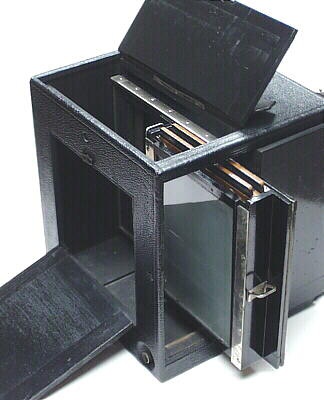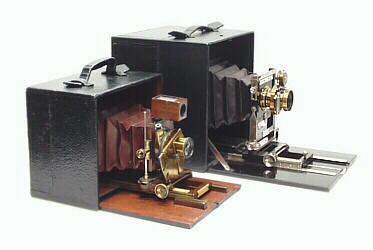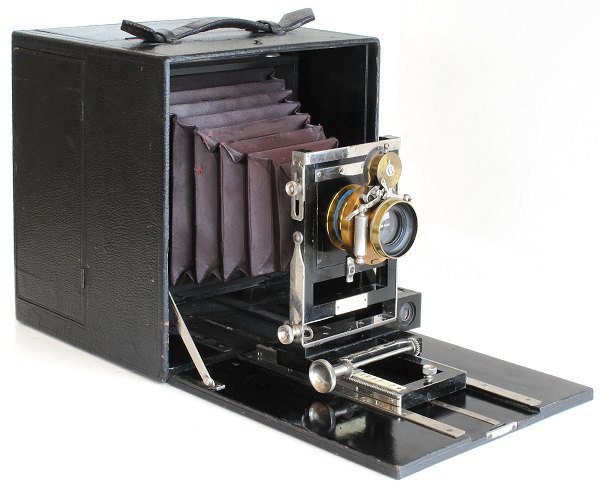|
|




Copyright ©2001 by Rob Niederman - ALL RIGHTS RESERVED
Visit the Anthony Marlborough Reference page
Return to the Self-Casing Cameras page
Return to the Self-Casing Cameras page
While the 1891 The Henry Clay Camera represented a significant step
forward in self-casing folding camera design, there was still room for
new features.
In 1896, the American Optical Company introduced an improved self-casing folding camera - one that combined the best design features of the Henry Clay Camera and the Irving View camera.
Advertised as the Irving-Clay Camera, references and catalogue entries illustrate a camera that borrowed heavily from the Henry Clay Camera (e.g. distinctive reflex finder, red leather bellows, focusing rails and bed).
The Irving-Clay is historically interesting because it was one of the first self-casing folding cameras to incorporate a reversing back. The reversing back feature was not new and used for many years on view cameras. (Refer to Flammang's Patent Revolving Back Camera for historical background on reversing backs.)
In 1896, the American Optical Company introduced an improved self-casing folding camera - one that combined the best design features of the Henry Clay Camera and the Irving View camera.
Advertised as the Irving-Clay Camera, references and catalogue entries illustrate a camera that borrowed heavily from the Henry Clay Camera (e.g. distinctive reflex finder, red leather bellows, focusing rails and bed).
The Irving-Clay is historically interesting because it was one of the first self-casing folding cameras to incorporate a reversing back. The reversing back feature was not new and used for many years on view cameras. (Refer to Flammang's Patent Revolving Back Camera for historical background on reversing backs.)
Multi-Lens Cameras | View Cameras | Self-Casing Cameras | Solid Body Cameras | References & Advertisements
Home | What's New | Show Schedule | Wanted | For Sale | Links | Site Map | Email
Home | What's New | Show Schedule | Wanted | For Sale | Links | Site Map | Email
Origins of the Reversing Back The reversing back was considered a great convenience because the image orientation was changed without
remounting the camera on its stand. But the camera size significantly increased due to the new reversing back being built inside the main body. As
a result, the 5" x 7" camera became extremely large, measuring 10-1/2" high x 10" wide x 9" deep. The 8" x 10" camera (also offered) must have
needed a pack mule!
Competitors recognizing the merits of a reversing back quickly embraced the concept and improved upon the design. By making the reversing back an extension to the main body (sides flush with the body) as opposed to being inside the body, smaller cameras could be produced (but could no longer use a rollfilm back). As a note, the Irving-Clay Camera retained the ability of using both glass plates and rollfilm, but added a rear swing feature that is usually found on view cameras.
Another interesting feature found on the Irving-Clay was the ability for the entire front bed to be dropped below the body for wide-angle lenses. In contrast, the Eastman Kodak Company's Folding Kodak Cameras (Satchel style) built a bed with a hinged drop segment. In order to keep the lens in position while the entire bed was in the dropped position, the focusing rails were released from the bed and secured to the inner body floor. This same drop bed feature was later used on other self-casing cameras including selected Century Grand models after 1902.
However, the camera illustrated on this web-page is not the Irving-Clay, but the Marlborough Camera, made by E & H.T. Anthony Co. Surprisingly, it is identical in all aspects to the Irving-Clay Camera offered by the American Optical Company (the competition). The appearance of two identical cameras is not coincidence, but evidence that the companies collaborated years before their 1901 merger. Close cooperation between the companies is documented in letters dating from 1880 to 1886. (Note: The American Optical Company was owned by the Scovill & Adams Co., which merged with E & H.T. Anthony to form the Anthony & Scovill Co., New York, NY; 1902-1907.)
Competitors recognizing the merits of a reversing back quickly embraced the concept and improved upon the design. By making the reversing back an extension to the main body (sides flush with the body) as opposed to being inside the body, smaller cameras could be produced (but could no longer use a rollfilm back). As a note, the Irving-Clay Camera retained the ability of using both glass plates and rollfilm, but added a rear swing feature that is usually found on view cameras.
Another interesting feature found on the Irving-Clay was the ability for the entire front bed to be dropped below the body for wide-angle lenses. In contrast, the Eastman Kodak Company's Folding Kodak Cameras (Satchel style) built a bed with a hinged drop segment. In order to keep the lens in position while the entire bed was in the dropped position, the focusing rails were released from the bed and secured to the inner body floor. This same drop bed feature was later used on other self-casing cameras including selected Century Grand models after 1902.
However, the camera illustrated on this web-page is not the Irving-Clay, but the Marlborough Camera, made by E & H.T. Anthony Co. Surprisingly, it is identical in all aspects to the Irving-Clay Camera offered by the American Optical Company (the competition). The appearance of two identical cameras is not coincidence, but evidence that the companies collaborated years before their 1901 merger. Close cooperation between the companies is documented in letters dating from 1880 to 1886. (Note: The American Optical Company was owned by the Scovill & Adams Co., which merged with E & H.T. Anthony to form the Anthony & Scovill Co., New York, NY; 1902-1907.)
The Marlborough Camera, c.1898
E. & H.T. Anthony & Company, NY.
E. & H.T. Anthony & Company, NY.
Comparing the exact differences between Marlborough and Irving-Clay cameras is difficult because both cameras are rare, with few examples
extant. Closely reviewing references and advertisements, I could only find one difference between the two cameras; the Marlborough being
constructed of ebonized spruce with nickel fittings while the Irving-Clay was made of polished mahogany with brass hardware. Aside from this
esthetic difference, the cameras were identical; introduced in 1896, priced the same (e.g. $45 for the 6-1/2" x 8-1/2" model), and offered in 6-1/2"
x 8-1/2" and 8" x 10" sizes. The 5" x 7" size was introduced later.
The Marlborough appearing on this page is the 5" x 7" format with original Bausch & Lomb Diaphragm shutter and rapid rectilinear lens. This was the smallest available size and sold complete with two plateholders, lens and shutter for $60 (about $1,229 in year 2000 dollars!!!). For photographers who desired to specify their own lens and shutter, the body was available for $35 (about $717 in year 2000 dollars). As can be seen, this was a very expensive camera.
Even with design improvements, the Marlborough and Irving-Clay cameras were large for their format size and relatively expensive. Comparing 1896 prices, the Marlborough Camera cost $60 while the 5" x 7" Henry Clay Regular Camera (without reversing back) sold for $50. Although Marlborough and Irving-Clay cameras were widely advertised, their high price and relatively large size may have been a reason for not being popular with 1890s photographers. The growing ranks of 1890s amateurs would be attracted to less expensive self-casing plate cameras (e.g. Pocos and Premos) or the new instantaneous rollfilm box cameras, explaining why the Marlborough and Irving-Clay cameras are rarely found today.
The Marlborough appearing on this page is the 5" x 7" format with original Bausch & Lomb Diaphragm shutter and rapid rectilinear lens. This was the smallest available size and sold complete with two plateholders, lens and shutter for $60 (about $1,229 in year 2000 dollars!!!). For photographers who desired to specify their own lens and shutter, the body was available for $35 (about $717 in year 2000 dollars). As can be seen, this was a very expensive camera.
Even with design improvements, the Marlborough and Irving-Clay cameras were large for their format size and relatively expensive. Comparing 1896 prices, the Marlborough Camera cost $60 while the 5" x 7" Henry Clay Regular Camera (without reversing back) sold for $50. Although Marlborough and Irving-Clay cameras were widely advertised, their high price and relatively large size may have been a reason for not being popular with 1890s photographers. The growing ranks of 1890s amateurs would be attracted to less expensive self-casing plate cameras (e.g. Pocos and Premos) or the new instantaneous rollfilm box cameras, explaining why the Marlborough and Irving-Clay cameras are rarely found today.
The Marlborough Camera, 5x7 format.
B&L Diaphragm Shutter / RR Lens.
B&L Diaphragm Shutter / RR Lens.
Comparison of the Henry Clay and Marlborough cameras.
Note that both cameras are 5x 7 inch formats.
Detail of the internal reversing back. To reverse the orientation, the back was
removed via a side door, turned and replaced. The door on top of the body
facilitated the removal of the plateholder when in portrait orientation.
